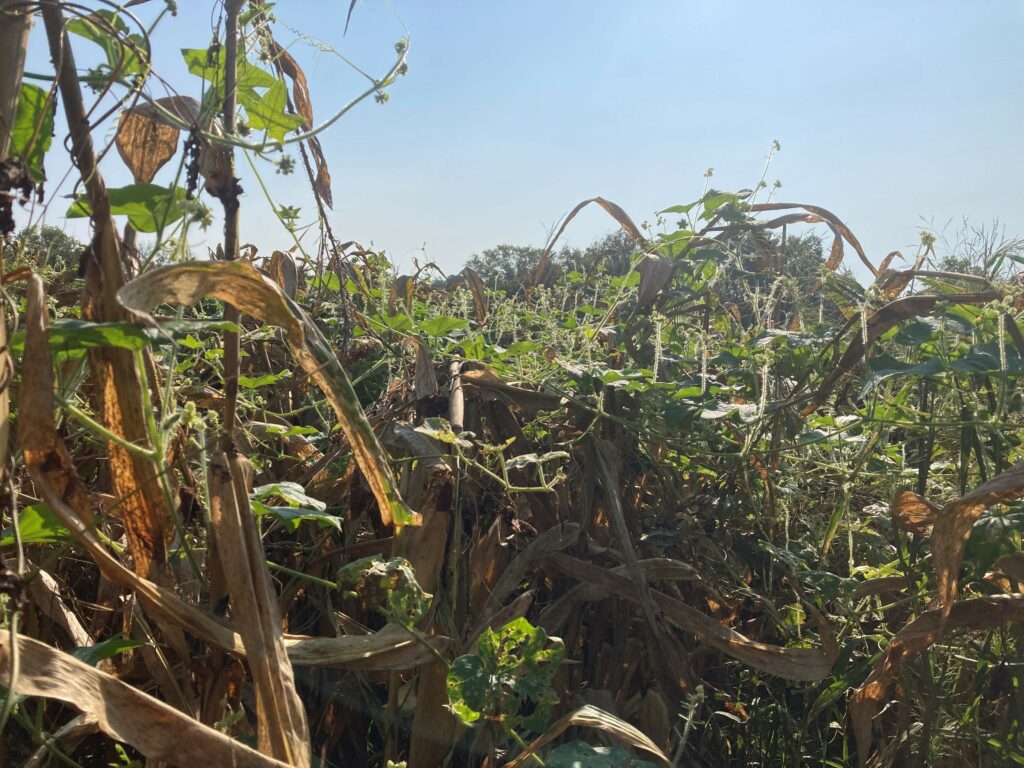
Practically every September some growers are dismayed at the vine infestations present at corn harvest. Often, these weed infestations emerged after PRE applied or early POST applied herbicides had played out. They grew very little until August and as the corn dried down and light became more available those established weeds started rapidly growing.
The vines in question are often perennial in growth habit like hedge bindweed and burcucumber. There is really no in-crop option that will provide good perennial vine control. The best one can achieve with an in-crop application is enough vine suppression to minimize harvest issues. Then after harvest allow the perennial vines to grow back for a couple weeks and then apply a good rate of glyphosate and dicamba. Since these vines often establish shortly after PRE or early POST herbicides have given out, a good strategy is to delay the typical POST application from V3 until V6 to V8. The herbicides of choice are those that can be applied to these later corn growth stages and provide suppression on these vines and control of other problem weeds.
Perennial vines do not get well established in fields in just a few years but rather over a period of many years. Likewise, complete control cannot be expected in a single year but require persistent fall treatments over a series of years to finally remove them from the field.
The best approach in crop options to mitigate perennial vines consists of…
Starting clean with either tillage or a burndown with Gramoxone 32 oz + Bicep 48 oz or Glyphosate 32 oz + Verdict 10 oz or Glyphosate 32 oz + Leadoff 2 oz. If no residual is used with the burndown consider applying a Group 15 herbicide (Dual Magnum, Warrant, Zidua, etc) + atrazine PRE. Then POST emergence apply….
Option 1. Capreno (tembotrione + thiencarbazone) 3 oz + Glyphosate 32 oz. Can be applied up to 7 leaf tall corn. Always add COC at a rate of 1.25 pts/100 gal. This herbicide has been around for a few years and has proven to have better residual control of vines than some other corn herbicide premixes. Much of that is provided by the thiencarbazone.
Option 2. Acuron GT (Dual II Magnum + Callisto + bicyclopyrone + glyphosate) 3.75 pt. Can be applied up to 8 leaf tall corn. Be sure to add an NIS surfactant at a rate of 1 qt/100 gal. This herbicide is fairly new and is essentially Halex GT with the HPPD inhibitor bicyclopyrone replacing atrazine. The bicyclopyrone will provide better residual control of most weeds than one could expect from atrazine.
Option 3. Spirit (primisulfuorn + prosulfuron) 1 oz + dicamba 0.25 lbs + Glyphosate 32 oz. Can be applied up to 20” tall corn. This herbicide likely would be hard to get as not used much in 20 years. Spirit herbicides tankmixed with Accent or dicamba was the overall most effective perennial vine recommendation prior to the advent of Roundup Ready corn (1998). Adding the glyphosate in with Spirit and dicamba will help improve the likelihood the vines will be less troublesome at harvest.
Atrazine is not a tankmix option since the corn is over 12” tall at V6 to V8. However, 4 ozs of Status tankmixed with either Acuron GT or Capreno will help both knockdown of existing vines and residual control of those weeds as well. Status can be applied up to 36” tall corn. Please keep in mind this strategy of later application can be easier to write than execute in the field. Applications after the label cutoffs can hurt corn pollination and grain set. In general, the later the application after the labeled maturity cut offs the higher the probability of poor pollination.

